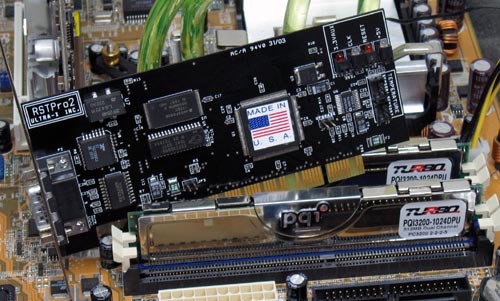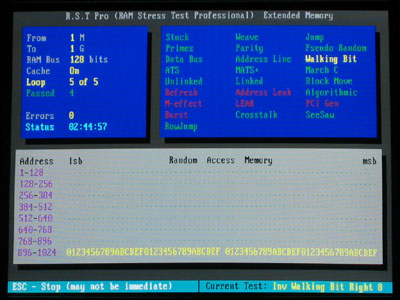PQI Turbo Memory — Enthusiast Memory??
Testing Methods
How Do We Define Stable Memory?
Have you ever run across a review web site that reviews a product and shows a couple amazing scores and gives it an award? Sure you do as most review sites do just that, but how stable was it? I would be willing to bet that most sites don’t know what stable memory is and therefore give fairly inaccurate results. Yes, I hate to break the news, but there is more than just running a memory bandwidth test and calling memory stable! Ever wonder what some of the memory companies use to test their modules? So did we, and we found out that they use the RAM Stress Test Professional 2 (R.S.T. Pro2). It is a Self-Booting, Operating System Independent memory diagnostic card for exercising and validating RAM. The R.S.T. Pro2 runs all tests in protected mode which can completely and thoroughly test up to 64 gigabytes of memory. This utility provides users the options of running sophisticated test patterns to detect hard to find memory errors, which are not detected by other test software.

While using the R.S.T. Pro2 we were able to find memory errors that other testing methods could not find or reproduce. Since we want and encourage our readers to follow up our testing on their own, we also used the free testing program called Memtest86 which is a stand alone memory test for x86 architecture computers that boots off a floppy disk. This software was getting old was unable to run on all platforms, so we will stick to the RST Pro2 for the time being. In recent months Chris Brady and some of the guys over at x86-secret have come up with Memtest86+, which is an updated version of the original program and it still happens to be free.
We also ran Prime95 while running loops of 3dmark2001 for a minimum of twelve hours to make sure that under hours of stress and heat buildup that the modules were truly stable.
We considered memory stable when it was able to run 1 extended pass of Memtest86+, twelve hours of Prime95/3dmark testing and ran without locking up while running all tests on the RST Pro2. Many consider if any errors are found using the RST Pro2 testing the memory has failed.
By this combination of tests we feel that this review is one of the most accurate completed in terms of memory stability. Sure, not everyone will agree with our stability testing methods, but not everyone can afford the cost of a review like this nor the time that went into this testing.
Bottom Line:
There is no industry standard for professional reviewers, but hopefully reviews like this will cause other professional reviewers to change their methods and ways of looking at memory.

Results:
The RST Pro2 tested the Base/Extended memory and after 5 loops no errors were found! Memtest86 was used and confirmed these results.
| RST Pro2 Stability Testing Results | ||
|---|---|---|
|
Timings |
Voltage |
Results |
|
Default |
2.65V (default) |
PASS |
|
2-2-2-5 |
2.85V |
208MHz (DDR 416) |
|
2.5-3-3-7 |
2.85V |
271MHz (DDR 542) |
|
3-4-4-8 |
2.85V |
282MHz (DDR 564) |
We then went on using the RST Pro2 to find the highest stable FSB for some popular memory timings. For this we used the timings shown in the above chart, and with the voltage set at the max (2.85V) we went to the breaking point. This point is of course the spot where the modules started throwing errors. As you can tell the modules were only stable up to 208 MHz (DDR416) at 2-2-2-5 timings, but when setting the timings looser watch out! These modules, like others we’ve seen using these IC’s, have tons of head room in them. At 2.5-3-3-7 our review modules reached 271MHz (DDR542) and an amazing 282MHz (DDR564) at the loosest possible timings. Did I forget to mention that all these tests were done with Turbo Mode enabled and Performance Acceleration Mode enabled in the BIOS! So far these modules look like some stable memory that has a very high overhead when run at loose timings.
Let’s take a look at the benchmarks and see how the PQI PC-3200 Turbo memory fairs against a popular brand of enthusiast memory.

Comments are closed.